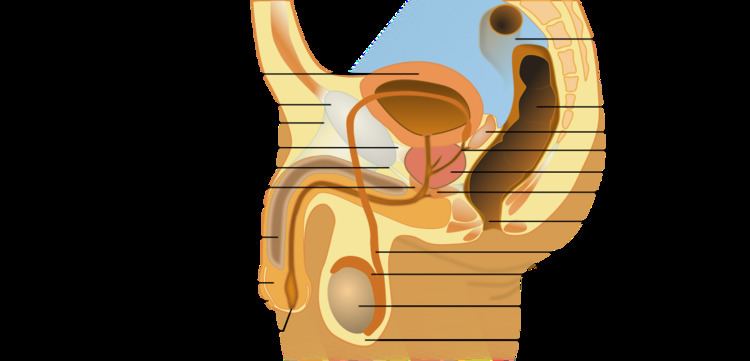Precursor Wolffian duct FMA 19234 | MeSH A05.360.444.930 | |
 | ||
Latin Vas deferens (plural: vasa deferentia),Ductus deferens (plural: ductus deferentes) | ||
The vas deferens (Latin: "carrying-away vessel"; plural: vasa deferentia), also called ductus deferens (Latin: "carrying-away duct"; plural: ductus deferentes), is part of the male reproductive system of many vertebrates; these vasa transport sperm from the epididymis to the ejaculatory ducts in anticipation of ejaculation.
Contents
Structure
There are two ducts, connecting the left and right epididymis with the seminal vesicles to form the ejaculatory duct in order to move sperm. In humans, each tube is about 30 centimeters (1 ft) long, 3 to 5 mm in diameter and is muscular (surrounded by smooth muscle). Its epithelium is pseudostratified columnar epithelium lined by stereocilia.
They are part of the spermatic cords.
Blood supply
The vas deferens is supplied by an accompanying artery (artery of vas deferens). This artery normally arises from the superior (sometimes inferior) vesical artery, a branch of the internal iliac artery.
Function
During ejaculation, the smooth muscle in the walls of the vas deferens contracts reflexively, thus propelling the sperm forward. This is also known as peristalsis. The sperm is transferred from the vas deferens into the urethra, collecting secretions from the male accessory sex glands such as the seminal vesicles, prostate gland and the bulbourethral glands, which form the bulk of semen.
Contraception
The procedure of deferentectomy, also known as a vasectomy, is a method of contraception in which the vasa deferentia are permanently cut, though in some cases it can be reversed. A modern variation, which is also known as a vasectomy even though it does not include cutting the vas, involves injecting an obstructive material into the ductus to block the flow of sperm.
Investigational attempts for male contraception have focused on the vas with the use of the intra vas device and reversible inhibition of sperm under guidance.
Disease
The vas deferens may be obstructed, or it may be completely absent in a condition known as congenital absence of the vas deferens (CAVD, a potential feature of cystic fibrosis), causing male infertility. Acquired obstructions can occur due to infections. To treat these causes of male infertility, sperm can be harvested by testicular sperm extraction (TESE), microsurgical epididymal sperm aspiration (MESA), or other methods of collecting sperm cells directly from the testicle or epididymis.
Uses in pharmacology and physiology
The vas deferens has a dense sympathetic innervation, making it a useful system for studying sympathetic nerve function and for studying drugs that modify neurotransmission.
It has been used:
Other animals
Most vertebrates have some form of duct to transfer the sperm from the testes to the urethra. In cartilaginous fish and amphibians, sperm is carried through the archinephric duct, which also partially helps to transport urine from the kidneys. In teleosts, there is a distinct sperm duct, separate from the ureters, and often called the vas deferens, although probably not truly homologous with that in humans.
In cartilaginous fishes, the part of the archinephric duct closest to the testis is coiled up to form an epididymis. Below this are a number of small glands secreting components of the seminal fluid. The final portion of the duct also receives ducts from the kidneys in most species.
In amniotes, however, the archinephric duct has become a true vas deferens, and is used only for conducting sperm, never urine. As in cartilaginous fish, the upper part of the duct forms the epididymis. In many species, the vas deferens ends in a small sac for storing sperm.
The only vertebrates to lack any structure resembling a vas deferens are the primitive jawless fishes, which release sperm directly into the body cavity, and then into the surrounding water through a simple opening in the body wall.
